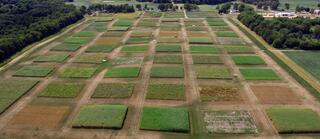Field Experiments

The Great Lakes Bioenergy Research Center (GLBRC) conducts field experiments in Michigan and Wisconsin at several sites associated with Michigan State University and University of Wisconsin–Madison agricultural experiment stations. Long-term field experiments are the basis for understanding the real-world performance of different bioenergy crops and varieties with respect to yields; plant-microbe interactions; biogeochemical attributes like soil carbon accretion, nitrous oxide emissions, and nitrate loss; biodiversity impacts; and life cycle assessments of overall climate benefits. Results are used to test hypotheses about productivity, carbon intensity, and the soil-plant-microbe interactions that confer plant resilience to stress, and as well to understand the environmental performance of alternative cropping systems. Field experiments also provide the basis for parameterizing and validating simulation models that allow GLBRC results to be projected to other locations across the U.S.
Current Field Experiments
Biofuel Cropping System Experiment (BCSE)
The BCSE was established in 2008 to examine the performance of potential bioenergy cropping systems, including assessments of crop yield and quality, microbial-plant interactions, biogeochemical responses such as greenhouse gas fluxes, water needs, nutrient leaching to groundwater, and biodiversity. Ultimate goals are to model the production efficiencies and environmental impacts of different bioenergy crops. Crops include energy sorghum, switchgrass, miscanthus, poplar, a 5-species native grass mix, early successional vegetation, restored prairie, and continuous corn reference crop. For more details click here.
Bioenergy Lands Experiment
The Bioenergy Lands Experiment (formerly Marginal Lands Experiment) was established in 2013 at five sites in Wisconsin and Michigan to evaluate the potential use of low productivity fields abandoned from agriculture for low input bioenergy feedstocks. Three sites in Michigan and two in Wisconsin are planted with replicated plots of switchgrass, miscanthus, a mix of five native grass species, poplar, early sucessional vegetation, and restored prairie. For more details click here.
Switchgrass Nitrogen Rate Experiment
GLBRC's Switchgrass Nitrogen Rate Experiment was established in 2008 to examine the effects of nitrogen fertilization levels on switchgrass productivity, greenhouse gas emissions, carbon intensity, and nitrate loss. Until 2012 the experiment also included a harvest frequency treatment. For more details click here.
Scale-up Experiment
GLBRC's Scale-up Experiment was established in 2009 at the Marshall Farm and Lux Arbor Reserve of KBS to provide a field-scale context for addressing scale-dependent questions about biofuel production and land use change. Four fields at Marshall Farm were in the USDA Conservation Reserve Program (CRP) from 1987-2008; in 2009 three were planted to continuous corn, switchgrass, or restored prairie and one remained as CRP brome grass to serve as a reference field. The three fields at Lux Arbor were managed in a tilled corn-soybean-wheat rotation (AGR) before biofuel establishment. For more details click here.
Switchgrass Variety Experiment II
GLBRC's Switchgrass Variety Experiment II was established in 2021 to examine the productivity, and feedstock quality, microbiomes, and carbon sequestration potentialGLBR of nine different switchgrass varieties, including three upland, three lowland, one coastal, and two hybrid varieties. Upland varieties are Blackwell, Cave-in-Rock, and Summer; lowland varieties are Alamo, Kanlow, and Cedar Creek. The coastal variety is Timber, and hybrid varieties are Liberty (crossed upland-lowland), and Shawnee (modified upland). Half of each plot receives nitrogen fertilizer. For more details click here.
Switchgrass Biodiversity Experiment
GLBRC's Switchgrass Biodiversity Experiment was established in 2024 to examine benefits of forb (flowering plant) composition on productivity, biodiversity, soil carbon gain, and other ecosystem services provided by switchgrass. Treatments include four different switchgrass proportions: 100%, 90%, 80%, and 60%, with the remaining percentages comprised of restored prairie forb species. For more details click here.